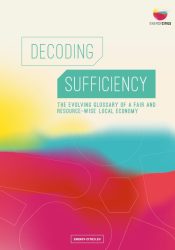Circular Economy and doughnut economics
What is at the Center of a resource-wise society?
Circular economy is becoming more and more popular in Europe, with cities and countries (like Finland) adopting roadmaps. The circular economy has the merit of setting up sustainable production schemes that limit consumption and waste or resources. However, the existence and the overlook of a circular rebound effect is a real trap. We commonly define rebound effect in a context of progress of efficiency (read our definition in the glossary, p14). Yet, a rebound effect is also observed in a circular economy when implementing circular solutions results in a higher environmental impact instead of a lower environmental impact. environmental impact. For instance, replacing disposable plastic bags with cotton todbags has a positive impact, provided that the bag is reused several times; if not, the plastic bag has a lower environmental impact. The existence of the circular rebound effect underlines the priority we must give to reducing the consumption of resources over their reuse and recycling in a circular economy.
Circular economy means reducing, over reuse and recycle
Circular economy is often connected to a popular tryptic: reduce, reuse, and recycle. But the order in which stakeholders consider these keywords matters, as MEP Bas Eickhout (Greens/EFA) emphasizes at the Beyond Growth conference:
“Circular economy is still a bit of a hobby project for politicians: everyone likes it, no one is against it. But it is absolutely not fundamentally addressed […]. If you go to fundamental parts of circularity, you will get to targets for material reduction and then it will also start hurting.”.
Reducing demand for any resource should be at the forefront of any circular economy strategy. As it requires a strong political will and courage it is often neglected. Hence, some tools and models have been used by cities to develop a circular economy within planet boundaries, the Doughnut economy is one of them.
Circular economy means taking into account environmental and social limits
The doughnut theory has been developed by the British economist Kate Raworth and is now implemented in more than 70 cities around the world. The idea of the doughnut is simple: the doughnut materializes an ecologically safe and socially just space where society can thrive respecting an ecological ceiling and a social floor.
The Brussels Capital Region has adopted the doughnut as a compass for its economic transition. One concrete translation in Brussels is the exemplarity decree, currently under discussion. The decree lays down the environmental and social exemplarity conditions to be met in order to receive public subsidies, by 2030. Among the conditions for environmental exemplarity, there is that of contributing to a more circular economy, especially by adopting a more rational use of resources. Thus, the circular vision in Brussels is embodied in the be.circular and circular innovation calls which follow the doughnut philosophy. One great example is the PermaFungi initiative, supported by be.circular and circular innovation where coffee grounds are reused to make a substrate for oyster mushrooms and part of this substrate is also transformed into sustainable material for isolation.
Even if in Brussels, as in Amsterdam and other cities, the doughnut is making great strides in the economic and ecological transition, cities are often limited to the power of their local instruments, which are sometimes not enough.
Circular economy means structural changes in legislation
Stéphanie Lepczynski, policy advisor to Barbara Trachte’s cabinet, explains that in the frame of the Shifting Economy strategy, they realize the limits of their regional economic tools, particularly in helping slow-fashion entrepreneurs: “As a regional authority, we are supporting them with all the economic instruments at our disposal, but it is not enough. We need strong and ambitious supra-national legislation to ensure fair competition between, on the one hand, the entrepreneurs who respect the ecological ceiling and social foundations, and on the other hand, the (big) companies that don’t”.
In the building sector, the need for legislative change is also felt, in order to apply circularity. The city of Tampere adopted recently its circular economy plan with a strong focus on the very material-intensive construction sector. Irina Simola, senior specialist in circular economy at the city, explains that “there are also legislative constraintsto the application of the plan, particularly as there is a lack of clarity and coherence around what qualifies as waste and falls under preparation for reuse of materials”.
For any resource, cities implementing circular economy, or the doughnut need structural change in legislation, enabling them to truly become a resource-wise society.
Conclusion
As the concept of the circular economy gets more and more popular, it is important to define it precisely. Circular economy can lead to a resource-wise economy, if priority is given to reducing pressure on resources. In this sense, a circular economy needs a sufficiency-based approach, which must enshrine the avoidance of resource consumption in structural legislation and daily practices. The European Union faces a major challenge that must be tackled, as it is only on a larger scale that the rules of the economic game can be changed, and a resource-wise economic model defined.
This article is part of the series of “Decoding Sufficiency” articles supported by ADEME. Subscribe to the “resource-wise and socially just local economies” hub newsletter to read future articles.

